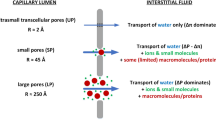Summary
Equations for studying quantitatively the capillary permeability using high molecular substances (dextran, polyvinylpyrrolidone) are given for 3 cases: 1. two pore sizes, 2. pores and vesicle transport (cytopempsis, pinocytosis) and 3. pores and diffusion through the endothelial cells (membrane diffusion). From the dependence of the concentration quotient lymph/plasma on the molecular weight the pore size can be calculated: a radius of 35–40 Å for the small, 600 to 700 Å for the large pores, and 200–300 Å for the vesicles are obtained from Grotte's results. His experiments with increased venous pressure can be better explained by a mechanism independent of pressure (cytopempsis or membrane diffusion) than by a filtration through large pores. Small molecules pass the capillary wall mainly by diffusion through small pores, large molecules by vesicle transport or membrane diffusion.
Zusammenfassung
Für quantitative Untersuchungen der Capillarpermeabilität mit hochmolekularen Substanzen (Dextran, Polyvinylpyrrolidon) werden für drei Fälle Gleichungen angegeben: 1. zwei Porengrößen, 2. Poren und Bläschentransport (Cytopempsis, Pinocytosis), 3. Poren und Diffusion durch die Endothelzelle (Membrandiffusion). Aus der Abhängigkeit des Konzentrationsquotienten Lymphe/Plasma vom MG kann die Porengröße berechnet werden. Aus Grottes Ergebnissen wurde ein Radius von 35–40 Å für die kleinen, 600–700 Å für die großen Poren und 200–300 Å für die Bläschen erhalten. Seine Versuche mit erhöhtem Venendruck lassen sich besser durch einen druckunabhängigen Mechanismus (Cytopempsis oder Membrandiffusion) als durch Filtration durch große Poren erklären. Kleine Moleküle passieren die Capillarwand vorwiegend mittels Diffusion durch kleine Poren, große Moleküle mittels Bläschentransport oder Membrandiffusion.
Similar content being viewed by others
Literatur
Creese, R., J. L. d'Silvá, and D. M. Shaw: Interfibre fluid from guinea pig muscle. J. Physiol. (Lond.) 162, 44–53 (1962).
Einstein, A.: Über die von der molekularkinetischen Theorie der Wärme geforderte Bewegung von in ruhenden Flüssigkeiten suspendierten Teilchen. Ann. Phys. 17, 549–560 (1905).
Faxén, H.: Die Bewegung einer starren Kugel längs der Achse eines mit zäher Flüssigkeit gefüllten Rohres. Ark. Mat. Astr. Fys. 17, Nr. 27, 1–28 (1922).
Ferry, J. D.: Statistical evaluation of sieve constants in ultrafiltration. J. gen. Physiol. 20, 95–104 (1937).
Grotte, G.: Passage of dextran molecules across the bloodlymph barrier. Acta chir. scand., Suppl. 211 (1956).
— L. Juhlin, and N. Sandberg: Passage of solid spherical particles across the blood-lymph barrier. Acta physiol. scand. 50, 287–293 (1960).
Hogben, C. A. M., D. J. Tocco, B. B. Brodie, and L. S. Schanker: On the mechanism of intestinal absorption of drugs. J. Pharmacol. exp. Ther. 125, 275 bis 282 (1959).
Manegold, E., u. K. Solf: Über Kapillarsysteme XIV. Die Dynamik osmotischer Zellen. Kolloid.-Z. 59, 179–195 (1932).
Mayerson, H. S., C. G. Wolfram, H. H. Shirley jr., and K. Wasserman: Regional differences in capillary permeability. Amer. J. Physiol. 198, 155–160 (1960).
Moore, D., and H. Ruska: The fine structure of capillaries and small arteries. J. biophys. biochem. Cytol. 3, 457–462 (1957).
Palade, G. E.: Fine structure of blood capillaries. J. appl. Physics. 24, 1424 (1953).
--The endoplasmic reticulum. J. biophys. biochem. Cytol. 2, Suppl. 85–98 (1956).
— Transport in quanta across the endothelium of blood capillaries. Anat. Rec. 136, 254 (1960).
— Blood capillaries of the heart and other organs. Circulation 24, 368–388 (1961).
Pappenheimer, J. R.: Passage of molecules through capillary walls. Physiol. Rev. 33, 387–423 (1953).
— E. M. Renkin and L. M. Borrero: Filtration, diffusion and molecular sieving through peripherical capillary membranes, a contribution to the pore theory of capillary permeability. Amer. J. Physiol. 167, 13–46 (1951).
—, and A. Soto-Rivera: Effective osmotic pressure of the plasma proteins and other quantities associated with the capillary circulation in the hind limbs of cats and dogs. Amer. J. Physiol. 152, 471–491 (1948).
Renkin, E. M.: Capillary permeability to lipid-soluble molecules. Amer. J. Physiol. 168, 538–545 (1952).
— Capillary and cellular permeability to some compounds related to antipyrine. Amer. J. Physiol. 173, 125–130 (1953).
— Filtration, diffusion and molecular sieving through porous cellulose membranes. J. gen. Physiol. 38, 225–243 (1954).
— Stofftransport durch die Wände der Blutcapillaren. Klin. Wschr. 41, 147–152 (1963).
— Transport of large molecules across capillary walls. Physiologist 7, 13–28 (1964).
—, u. J. R. Pappenheimer: Wasserdurchlässigkeit und Permeabilität der Capillarwände. Ergebn. Physiol. 49, 59–126 (1957).
Rusznyák, I., M. Földi u. G. Szabó: Physiologie und Pathologie des Lymphkreislaufes. Jena: G. Fischer 1957.
Vogel, G., H. Ströcker u. M. Höller: Die Penetration von Polyvinylpyrrolidon durch die Plasma-Lymph-Schranke bei Ratten. Pflügers Arch. ges. Physiol. 279, 187–191 (1964).
Winne, D.: Theoretische Überlegungen zur Frage, ob die Wand der Blutkapillaren sich funktionell wie eine Löslichkeits- oder Porenmembran verhält. Z. Naturforsch. 17b, 761–765 (1962).
— Rechnerische Überlegungen zum Wassertransport durch die Wand einer Blutkapillare. Z. Naturforsch. 18b, 783–787 (1963a).
— Eine theoretische Betrachtung zur Capillarpermeabilität. Pflügers Arch. ges. Physiol. 278, 374–382 (1963b).
Author information
Authors and Affiliations
Additional information
Mit 4 Textabbildungen
Rights and permissions
About this article
Cite this article
Winne, D. Die Capillarpermeabilität hochmolekularer Substanzen. Pflügers Archiv 283, 119–136 (1965). https://doi.org/10.1007/BF00363183
Received:
Issue Date:
DOI: https://doi.org/10.1007/BF00363183




